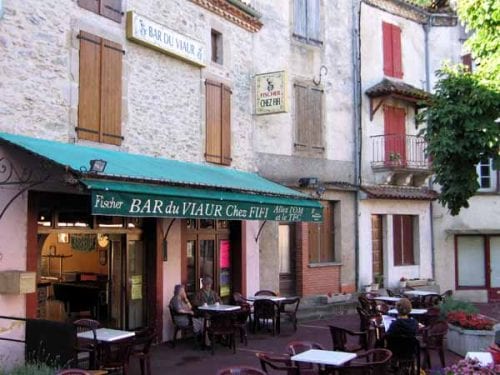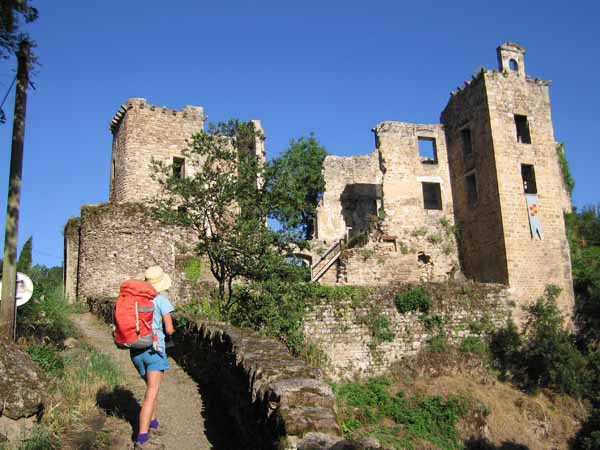
Wednesday, 20 July 2005
Distance 19 km
Duration 4 hours 25 minutes
Ascent 499 m, descent 455 m
Map 57 of the TOP100 blue series (now superseded)
Having found out that the bar on the highway opened at 8 am, we timed our departure nicely to arrive just in time.

Long planters of flowers separated the tables from the road and the nearby boulangerie provided a bag of pastries to have with our coffee.
We found out in the paper that the Tour de France would be departing from Albi tomorrow at noon, unfortunately not in the direction we would be coming from.

Leaving town by the bridge near the weir, we climbed past the skeleton of the château, which was hung with banners although only half-restored, and entered a wood.
After a while we came out into fields, mildly rounded rather than hilly, and full of picturesque details – farmhouses, hedges, little roads, groves of trees. It was delightful, easy walking.
Once we reached the highest point we could see the village of Cordes crouching on its dome at the far side of the valley, but it was still a long way away, as we discovered.

The rambling descent to the river brought us at last to les Cabannes, a sort of poor relation to Cordes at the base of the hill.
In the main street we were pleased to find the mundane comfort of a hotel with a terrace, where we could stop for coffee, as Keith had a nasty new blister forming on his heel in the remains of the previous one.
Back on the GR, we pottered along beside the river until we reached the old cobbled path that turned uphill, zig-zagged through steep lanes and finally went under a great archway into the top streets of Cordes.

We found ourselves in the Place de la Halle and it was as crowded as it ever would have been on market day in the thirteenth century, but now with tourists instead of peasants.

The bastide of Cordes was established in 1222 by the Count of Toulouse, himself a Cathar, and attracted great numbers of heretics seeking protection in the time of the Inquisition. T
here was such a population explosion that the defensive outer wall had to be expanded repeatedly, so that now there are the remains of five separate concentric walls.
It was only in 1993 that the name was changed to Cordes-sur-Ciel, referring to the way the village seems to float on the mist of the valley like a heavenly vision.

The nearby Office of Tourism was more of a Palais then an Office, and the only modern building in sight. We found out that the camping ground was two kilometres away on the road to Gaillac, and that there was an internet point in the low town on the way to it, at the post office.
We ate our picnic lunch on a stone bench under the halle, then wended our way down through layers of broken wall, to the low town, which was small and unprepossessing.
A short walk along the highway brought us to the camping ground, just past the turn-off to Gaillac. The woman in charge showed us to a spot near a stream, shaded by a line of poplars, where, for a change, we found the ground covered with fine, smooth grass instead of dust and stones. She said we would be tranquil there.
The shower block was a temple to hygiene, all orange laminex and stainless steel. Having washed off the dust of the track and rested briefly, we returned to the low town in the hot afternoon sun to send an email.

At the post office we were told that we would have to pay €7, the price for an hour, and that they were closing in half an hour.
It was not enough time anyway, so we retired to a bar to build up our strength for the climb to the old town. We took our coffee indoors so that we could watch on TV the end of that day’s stage of the Tour de France, the sprint into Revel.
When some of the heat had drained out of the air, we set off up the precipitous lanes, where the stones were still pumping out their stored warmth. Just inside the topmost ramparts we occupied a café table that jutted over the abyss, a windy spot but glorious. Paragliders hung in the sky in company with drifts of birds.

We had a pastis and a white wine and looked at our maps to decide how to get to Albi tomorrow, as there was no GR going that way.
We did not have the TOP100 map, only a photocopy from a road atlas, plus the map I had found beside the road near Saint-Géry, so it was rather difficult.
The eateries in Cordes were divided into two groups, the breathtakingly expensive and the surprisingly cheap. We chose one of the latter sort, that advertised regional cuisine and had tables set out under trees near the ramparts.
We began with salade aveyronnaise (a normal salade composée with the addition of a hard-boiled egg and some sliced sausage), then steak with Roquefort sauce and aligot-saucisse.

This aligot had more elasticity than the one at Najac, but was not a patch on the ones we had eaten on the pilgrimage.
Back at the camping ground, we found we were no longer in tranquillity. The other places had all filled up.
Next to us were a couple from Durham who invited us to share their bottle of Châteauneuf-du-Pape, an extremely generous gesture given the price of it. They were amateur cyclists but did not know, till we told them, about the start of the Tour from Albi tomorrow.
Leaving Cordes
There is a railway station at at Cordes-Vindrac which is 3 km west of Cordes. From there you can go to almost anywhere in France.